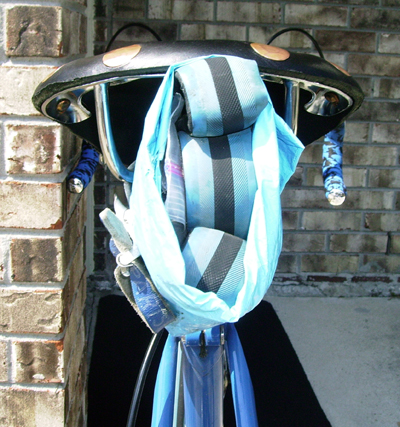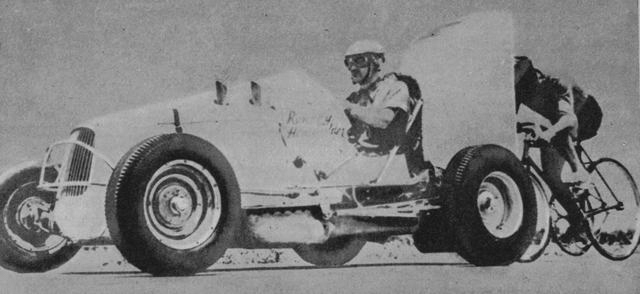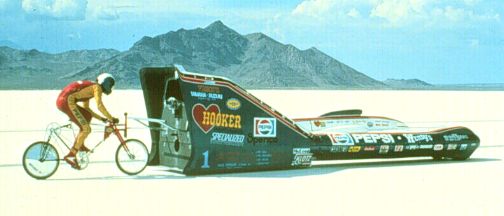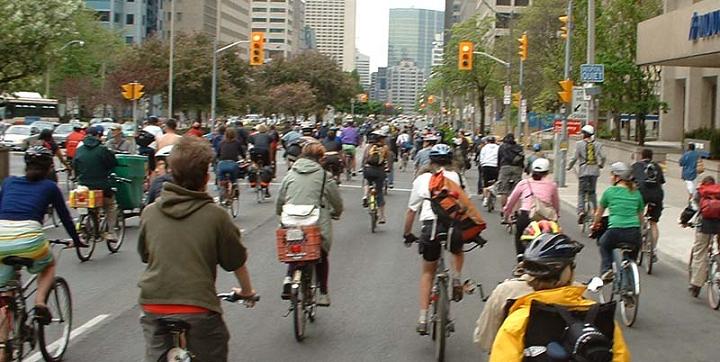What’s wrong with this picture?
 Thu, August 14, 2008
Thu, August 14, 2008 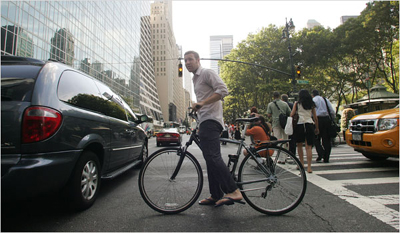
The above picture is from an article in the New York Times titled “Moving Targets.”
The piece focuses on the turf war on our roads and city streets between cyclists and motorists. Negative stuff, which I hate; however, the negativity is not all biased towards one side or the other.
As they say in show business, any publicity is good publicity; at least the press is giving considerable space to the subject and possibly, if we get enough of it, people will begin to see how ludicrous the whole “Us vs. Them” situation is. We are all just people trying to get somewhere or other.
With high gas prices, we are seeing more bikes on the road, which is a good thing. Or it would be, except we now have a bunch of people in the mix who often don’t have a clue. Look at the guy in the above picture.
The traffic light in the background is about to turn red, which means this person on a bike was trying to get across the intersection while the light was against him. His near side pedal is at the bottom, not up where it should be, ready to push off when there is a gap in traffic.
And look what he has on his feet, flip-flops. In the midst of his scramble to get across the street, he is likely to stub his toe or lose his footwear altogether.
(On a totally irrelevant side note, I’m curious, don’t young guys get in fights anymore? You can’t kick someone’s ass wearing flip-flops. You can’t back up, and you can’t run away; you are screwed all around.)
Behind the cyclist, a lady in red is down on her haunches taking a picture, in the middle of the crosswalk just as the light is about to turn green and the yellow car waiting is about to run her over.
Of course she is a pedestrian and they don’t follow to many rules, but when people get on a bike and act with the mentality and lack of responsibly of a pedestrian, they are a menace to themselves and everyone else on the road.
This is what we are seeing, just pump the tires up and off you go.
“You can’t ride a bike in the city as an adult the way you did as a 10-year-old in a suburban cul-de-sac,” he said. “I see people riding like children on a sidewalk, or going the wrong way down a street.” (Cyclists should ride with traffic, not against it.) Bike Snob NYC
Or they ride their bike as they drive their car, in other words paying little attention to what is going on around them.
“They pull out without looking at traffic,” she said. “They don’t signal.”
Well of course they do, this is how they drive a car.
A pandemic of obliviousness, ear buds, texting, further ramps up the tension. Recently, Steve Diamond, ride coordinator for the Morris Area Freewheelers, a New Jersey cycling club, saw what he called a trisect of irresponsible cycling: “A guy riding his bike without a helmet, talking on his cell phone, with his kid in the bike attachment behind him.”
Is there anything those of us who a serious about our cycling do, amongst all this craziness? We could lead by example, and start by watching our own behavior.
"The ability of drivers and cyclists to trash talk and then disappear into the anonymity of traffic further poisons the atmosphere."
“Share the road” means just that. We all learned about sharing as a kid, if we are not prepared to share, how can we expect others to share with us?
I was out riding alone last weekend on a busy two-lane highway, with a shoulder. I dislike habitually riding on the shoulder; too many drivers have their wheels over the edge, while driving too close the vehicle in front. I was out in the lane where drivers can see me, and where they have to make a conscious effort to go around me.
However, at one point I could see traffic coming toward me, and was aware of a vehicle slowing behind me. I moved over on to the shoulder to let him pass; he was towing a large boat, and gave a friendly little “Beep-beep” as a thank you.
He had recognized that I had made an effort to accommodate him, and just maybe here is one driver who will see cyclists in a different light in future.
We none of us have control over how others behave on the road, be they cyclist, or motorist. However, as individuals we all have control over our own behavior. I always find I can be assertive as I ride, but still show respect for other road users. By showing respect, I get respect.
I am appealing at least for this time, that any comments on this post be positive. There was enough negativity in the NYT article, and we all have stories of how some Bozo in an SUV tried to run us down. The bike blogosphere is full of such stories.
What have you seen, or done lately that sheds a more positive light on this whole crazy situation? What ideas do you have to improve things? I don’t know about you, but I am growing weary of reading stories of cyclists being run down, attacked, etc. etc, etc.
 Dave Moulton | Comments Off |
Dave Moulton | Comments Off | 


















